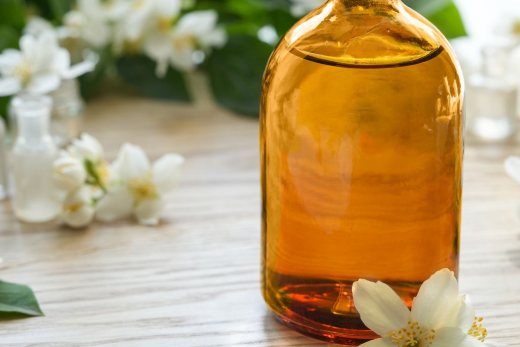Discover the beating heart of every fragrance: the heart notes. These intermediate aromas, which unfold just after the evanescence of the top notes, are essential in giving each fragrance its unique and memorable character. In this article, we will delve deep into heart notes, the unsung heroes of perfumery, captivating our senses and anchoring our olfactory memories. Learn how these essences influence the overall perfume experience, whether it's a women's perfume or a men's perfume, their role in longevity and sillage, and how to wisely choose your next olfactory signature based on these rich, enveloping notes.

Understanding the Heart Notes of Your Perfume
Heart notes, often considered the soul of a perfume, are those that manifest just after the evaporation of a perfume's top notes. They form the central part of the olfactory pyramid, providing depth and solidity to the fragrance. These notes are typically richer and more complex than the top notes and are designed to last longer on the skin before giving way to the base notes. To learn more about the components of a fragrance, check out our article on What is a perfume?
Unlike top notes, which are light and volatile, intended to immediately capture attention, heart notes develop and blossom on the skin, forming the very core of the olfactory experience. Base notes, on the other hand, are even more enduring and deep, providing a foundation upon which heart notes can shine. These notes play a crucial role in bridging the transition between the initially bright and volatile welcome of the top notes and the rich complexity of the base notes, ensuring a smooth and enriching progression of the fragrance. Thus, heart notes not only fill the gap between extreme notes; they define the true identity of the perfume and are often responsible for the most memorable traits of a fragrance.
Types of Ingredients in Heart Notes
Heart notes often reflect the complexity and richness of a perfume. They consist of a variety of ingredients that define the central character of each fragrance. Here's an exploration of the types of ingredients typically used in these intermediate notes, along with specific examples that illustrate their olfactory impact:
- Flowers: Floral notes are among the most commonly used in heart notes due to their ability to bring natural richness and romantic depth. They include flowers like rose, which adds a classic and elegant touch, and jasmine, known for its opulent and sensual fragrance.
- Spices: Spices add a warm and spicy dimension to heart notes. Cinnamon, for example, offers a sweet warmth while cardamom injects a unique spicy freshness.
- Ripe Fruits: Some fruits, heavier and sweeter, such as peach and blackcurrant, are often used for their juicy and enriching qualities.
These ingredients, through their diversity and complexity, play a crucial role in transitioning between the initial impact of top notes and the stability of base notes, thereby enriching the overall olfactory experience and ensuring the persistence of the perfume.
Choosing a Perfume Based on Its Heart Notes
Choosing the right perfume goes beyond appreciating the initial fragrances; heart notes are the ones that truly define the olfactory experience by settling durably on the skin. Here are some tips to help you identify the heart notes that resonate most with your preferences and effective methods to test them.
Tips for Identifying Preferences
- Define your olfactory tastes: Consider the scents you enjoy on a daily basis. If you're drawn to sweet and floral aromas, look for perfumes with heart notes dominated by flowers like rose or jasmine. If you prefer something spicier or fruitier, lean towards heart notes that include spices like cinnamon or ripe fruits.
- Consider the occasion: Some heart notes are more suitable for specific contexts. For example, light floral notes may be perfect for daytime, while richer, deeper notes like sandalwood or amber may be ideal for evenings.

Testing Perfumes
- Use test strips: Spray perfume on a test strip and let it rest for a few minutes to allow the top notes to evaporate. This will give you a better idea of what the heart notes truly smell like.
- Apply to skin: Perfumes can develop differently on the skin due to individual body chemistry. Apply a small sample on your wrist or elbow and assess how the perfume evolves throughout the day.
- Take your time: Heart notes take time to fully reveal themselves. Don't rush your decision; allow the perfume to express itself over several hours to fully understand its heart.
By following these tips, you can choose a perfume that not only pleases you from the first spray but continues to enchant you with its heart notes, ensuring prolonged satisfaction.

The Impact of Heart Notes on the Perfume Experience
Heart notes play an essential role in determining the overall olfactory experience of a perfume. They bridge the fleeting initial impression of top notes and the lasting depth of base notes. Here's how heart notes influence the evolution of the perfume on the skin and their impact on the longevity and sillage of the perfume.
Perfume Evolution
Heart notes emerge after the top notes have dissipated, usually between a few minutes and an hour after application. They constitute the majority of the olfactory experience, remaining perceptible for several hours. Their development on the skin can vary significantly depending on each individual's body chemistry, which can transform the same fragrance into subtly different scents from person to person. By mingling with the natural oils of the skin, heart notes reveal their full expression, giving the perfume its unique signature.
Longevity and Sillage
Heart notes are crucial for the longevity of a perfume. Due to their less volatile nature than top notes, they linger longer, supporting and enriching the base notes that follow them. Sillage, which is the olfactory trail that the perfume leaves in the air as the wearer moves, also heavily depends on heart notes. A well-defined sillage is often the result of a perfect harmony between powerful and attractive heart notes and deep, enveloping base notes. Heart notes, through their intensity and endurance, contribute to an olfactory signature that can remain perceptible even after the person has left the room.
Conclusion
Heart notes are undeniably at the heart of every perfume, shaping experiences that go far beyond the initial spray. They envelop us with their rich aromas and persist long after the initial notes have evaporated, offering depth and complexity that make each fragrance unique. We invite you to explore and discover the magic of heart notes for yourself.





